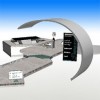Memory Plains Returning
Artist: Adam Nash, Australia,
The audiovisual manifestation of the resulting performance was similar, from an audience point of view, to the single-user version seen during the exhibition. So, what did it mean for the performance to be the 'live, multi-user version'? The multi-user space (realized using VNet, an open source java/vrml client/server system) is similar to any other multi-user space common these days. However, rather than presenting as avatars that attempt to portray the person in some way, the performers' avatars were actually parts of the audiovisual 'movements' of Memory Plains Returning. It was more like they were playing parts of the piece, except that in the multi-user space the performers are indistinguishable from their instruments. The piece, a gently unfolding meditation on the loss and return of memory through specific experience, is a highly 'composed' piece, meaning that the performers are conducted to carry out a predetermined set of instructions from which they don't deviate. It is analogous to a quartet playing a piece of scored music with no improvisation, although varying degrees of network lag were expected to create a kind of enforced external improvisation, as the perception of the performance would be different at any given time at any given site, and indeed this turned out to play a larger role than was expected, and created some interesting temporal/visual phenomena that are unique to the 3D multi-user space. From - Performance Report
Editor's Critique
The initial space is a black void. We enter as Adam's audience and become the audient (singular) - grey transparent balls with name badges. This remove the distractions of being visually human. We as audient are in sense alone and in a crowd immersed and focused on music. His musician avatars are seen as musical instruments / abstract buildings / rhythmic spaces that we, the audient explore.
This work was partly inspired by my own efforts doing poetry readings with shapeshifting avatars. Where I grew conservative and pursued education, Adam grew creative. Years later I would try doing a poetry reading in the black void – and it didn’t work. The poetry was linear and my work designed to be viewed from a set distance and direction. In the void my audience moved on its accord and often out of position. Unlike Adam’s work, mine required a minimal structure.
It’s unclear what it would take to make a concert as music video in a virtual space. I think Adam’s general path might be a singular genre, but I assume some architecture like mine is needed. Lastly if this seems like nonsense – imagine a virtual music concert, do you see yourself in a huge stadium, in a little fold out chair, while below you are tiny avatars pretending to be musicians? Giant screens above show the images of the avatars below.
Consider the screens above those musicians and extend them into the virtual, remove the seats and push video immersively around everyone. Something interesting happens...right? Consider a live online concert as a social music video mixed with a hint game play, engaged with through a Kinect or Eye Toy - maybe wearing an Oculus Rift.
- Genre: Yes, VRML / X3D, Music - Concerts, Abstract, PC
- Year: 1999
- Websites: http://yamanakanash.net/, http://yamanakanash.net/3dmusic/mprexp.html
Technology Used
VRML VNet (Multiuser)




